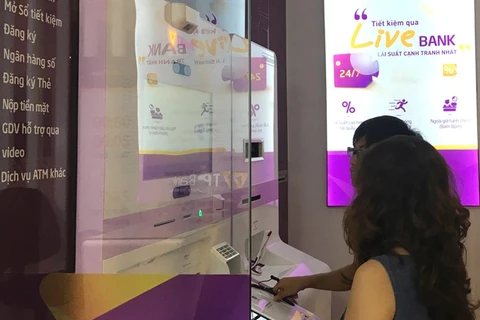 Vietnam strives to reduce cash payment proportion to less than 8 percent by 2025 (Source: Vietcombank)
Vietnam strives to reduce cash payment proportion to less than 8 percent by 2025 (Source: Vietcombank) Hanoi (VNA) - The Vietnamese Government plans to reduce the cash payment proportion to less than 10 percent by 2020 and 8 percent by 2025, which can be done by expanding the network of automatic teller machines (ATMs) and points of sale (POS) nationwide.
The target is set in the banking development strategy till 2025 with vision to 2030, which was recently approved by Prime Minister Nguyen Xuan Phuc.
Under this strategy, Vietnam aims to have at least 2 or 3 banks in Asia’s top 100 largest banks in terms of assets, and 3 to 5 banks listed on foreign stock markets by 2025.
The strategy also seeks to improve local banks’ competitiveness, enhance transparency in the banking sector and make the sector operate in accordance with international standards.
Accordingly, by the end of 2020, all banks are required to have equity capital in accordance with Basel II standards – a set of banking laws and regulations issued by the Basel Committee on banking supervision to enhance competition and transparency in the banking system and make banks more resistant to market changes.
To help State-owned banks achieve the equity capital requirements, the Prime Minister has instructed the State Bank of Vietnam (SBV), in conjunction with the Ministry of Finance and the Ministry of Planning and Investment, to map out and submit to the Government plans to increase capital for State-owned banks.
The new strategy also sets a goal of improving the SBV’s independence, activeness and accountability for directing monetary policy, controlling inflation, supporting macro-economic stability and fuelling sustainable economic growth.
It also looks to strengthen institutional capacity and banking supervision of the central bank, expand its scope of supervision into financial corporations with parent ones.
The banking system also plans to undergo a restructuring process in the 2018-2020 period with a focus on resolving bad debts and weak banks to ensure the bad debt ratio of the entire banking system is kept under 3 percent.
Other targets set forward by the strategy include finalising a legal framework for monetary policies and banks on the basis of market mechanisms and international standards, as well as improving foreign currency and gold policy management.
It also aims to enhance public access to financial and banking services, especially in rural, mountainous and poor areas.-VNA
VNA
























